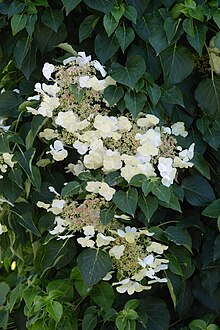Hydrangea anomala
| Hydrangea anomala | |
|---|---|
 | |
| Hydrangea anomala | |
| Scientific classification | |
| Kingdom: | Plantae |
| Clade: | Tracheophytes |
| Clade: | Angiosperms |
| Clade: | Eudicots |
| Clade: | Asterids |
| Order: | Cornales |
| Family: | Hydrangeaceae |
| Genus: | Hydrangea |
| Species: | H. anomala |
| Binomial name | |
| Hydrangea anomala | |
| Synonyms[1] | |
| List
| |
Hydrangea anomala, the Japanese climbing-hydrangea,[2] is a species of flowering plant in the family Hydrangeaceae native to the woodlands of the Himalaya, southern and central China and northern Myanmar.
It is a woody climbing plant, growing to 12 m height up trees or rock faces, climbing by means of small aerial roots on the stems. The leaves are deciduous, ovate, 7–13 cm long and 4–10 cm broad, with a heart-shaped base, coarsely serrated margin and acute apex. The flowers are produced in flat corymbs 5–15 cm diameter in mid-summer; each corymb includes a small number of peripheral sterile white flowers 2–3.5 cm across, and numerous small, creamy-white fertile flowers 1–2 mm diameter. The fruit is a dry urn-shaped capsule 3–5 mm diameter containing several small winged seeds.
The closely related Hydrangea petiolaris from eastern Siberia, Japan, and Korea, is sometimes treated as a subspecies of H. anomala; it differs in growing larger (to 20 m) and flower corymbs up to 25 cm diameter. The common name Climbing hydrangea is applied to both species.
Cultivation and uses
[edit]
Hydrangea anomala is grown as an ornamental plant. The subspecies H. anomala subsp. petiolaris has received the Royal Horticultural Society's Award of Garden Merit.[3]
Etymology
[edit]‘Hydrangea’ is derived from Greek and means ‘water vessel’, which is in reference to the shape of its seed capsules.[4]
‘Anomala’ means ‘anomalous’ or ‘unlike its fellows’.[4]
References
[edit]- ^ "The Plant List: A Working List of All Plant Species". Retrieved April 3, 2014.
- ^ BSBI List 2007 (xls). Botanical Society of Britain and Ireland. Archived from the original (xls) on 2015-06-26. Retrieved 2014-10-17.
- ^ "Hydrangea anomala subsp. petiolaris". RHS. Retrieved 28 August 2020.
- ^ a b Gledhill, David (2008). "The Names of Plants". Cambridge University Press. ISBN 9780521866453 (hardback), ISBN 9780521685535 (paperback). pp 50, 206


 French
French Deutsch
Deutsch